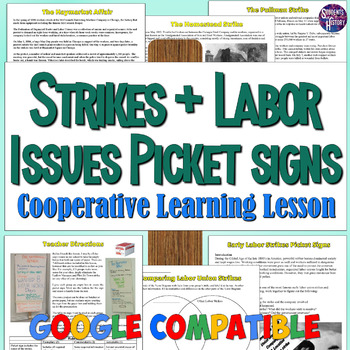Strikes & Labor Union Issues Picket Sign Lesson
- PDF
- Google Apps™

What educators are saying
Description
In this Industrial Revolution or Gilded Age Era lesson on Labor Strikes in US History, students create picket signs that tell the story of some of the most famous labor clashes in American History.
Included are 7 one-page stories on each of the events in the labor movement:
- Great Railroad Strike of 1877
- The Homestead Strike,
- Haymarket Affair
- Pullman Strike
- Ludlow Massacre
- Flint Sit-Down Strike
- Memorial Day Massacre
In groups, students read their article and create a picket sign that tells the story of that strike and present them to the class. As groups present, a table worksheet and Venn Diagram help students organize similarities and differences. Lastly, students complete a set of comprehension questions.
A rubric for the presentation is included as well as an page describing the procedures in detail and pictures of completed examples. This is a very fun activity that your student will remember and enjoy!
An editable Google Doc version of the activity is included along with a Google Slides template for a virtual "picket sign".
You can "Like" my page on Facebook for updates, giveaways, links and more! Thanks!





